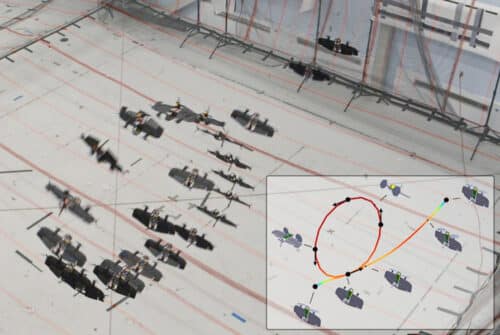The new approach empowers search-and-rescue tailsitter aircraft to strategize and accomplish intricate, high-speed acrobatic manoeuvres.

Credits:Image: Courtesy of the researchers
A tailsitter is an aircraft that launches and touches down vertically, resting on its tail, before transitioning to horizontal flight. More efficient and speedy than quadcopters, its capability to cruise like a plane and hover like a chopper makes it ideal for search-and-rescue or package delivery roles.
MIT researchers have developed new algorithms for the trajectory planning and control of tailsitters, leveraging the aircraft’s agility and adaptability. Enabling intricate manoeuvres like sideways and inverted flight, these algorithms compute complex trajectories in real time. In a drone race, the team demonstrated tailsitters performing actions like loops, rolls, and synchronised acrobatics. These algorithms empower autonomous tailsitter manoeuvres in dynamic situations, such as navigating collapsed structures and evading obstacles during survivor searches.
Tackling tailsitter trajectories
The team have recognized the necessity for trajectory planning and control algorithms tailored to agile trajectories involving rapid accelerations, which is crucial for unlocking the full potential of these distinctive aircraft. They adopted a universal dynamics model encompassing all flight conditions, spanning vertical take-off to forward or sideways flight. Employing the concept of differential flatness, they ensured the model’s efficient performance.
By harnessing differential flatness, the researchers introduce a streamlined approach, employing a mathematical function to assess trajectory feasibility rapidly. This methodology side steps intricate system dynamics by depicting the tailsitter’s trajectory as a mathematical curve in space, swiftly appraised for practicability using differential flatness. These trajectories, marked by intricate transitions between vertical and horizontal flight, encompass sideways and inverted manoeuvres. This agility arises from the algorithm’s astute design, ensuring comprehensive coverage of diverse flight conditions.
A tailsitter airshow
A standout trial featured a tailsitter executing a daring climbing turn: the aircraft veers left, swiftly accelerates, and skillfully banks to the right. Furthermore, the innovation took centre stage in a mesmerising tailsitter “airshow” where three synchronised aircraft embarked on loops, sharp turns, and navigated airborne gates seamlessly. The team affirms that these intricate manoeuvres, made possible by their model’s utilisation of differential flatness, would only be feasible for real-time planning with this mathematical framework.
The next step involves expanding the algorithm’s scope to facilitate proficient deployment in fully autonomous outdoor flight scenarios, wherein factors like wind and environmental conditions can significantly impact the behaviour of a fixed-wing aircraft.









